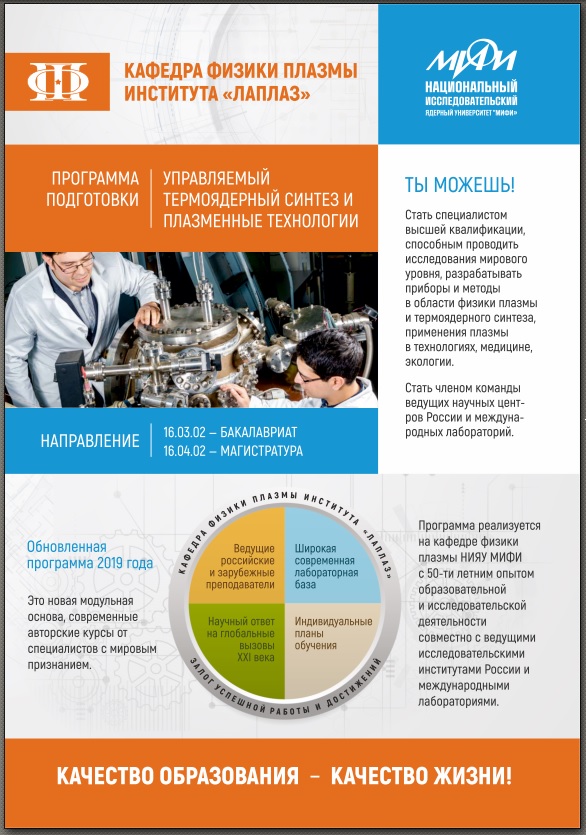Новости науки27 янв. 2016
НИЯУ МИФИ предложил уникальный способ удаления металлической пыли из термоядерных установокНа кафедре «Физики плазмы» НИЯУ МИФИ разработан способ удаления металлической пыли из термоядерных установок с помощью электростатических зондов. Подробнее...
20 янв. 2016
Статус государственного научного центра подтвердили семь организации «Росатома»16 янв. 2016
Андрей Гейм: графен может использоваться для очистки ядерных отходов 5 янв. 2016
Владимир Фортов. Интервью на "России 24". Эфир от 26.12.2015Насколько оправдывает себя реформа Академии наук? 10 дек. 2015
The first plasma in Wendelstein 7-X.10th December 2015: The first plasma in Wendelstein 7-X. It consisted of helium and reached a temperature of about one million degrees Celsius. (coloured black-and-white photo). On 10th December 2015 the first helium plasma was produced in the Wendelstein 7-X fusion device at the Max Planck Institute for Plasma Physics (IPP) in Greifswald. After more than a year of technical preparations and tests, experimental operation has now commenced according to plan. Wendelstein 7-X, the world’s largest stellarator-type fusion device, will investigate the suitability of this type of device for a power station. http://www.ipp.mpg.de/3984226/12_15
22 мая 2015
A little drop will do it: Tiny grains of lithium can dramatically improve the performance of fusion plasmasLeft: DIII-D tokamak. Right: Cross-section of plasma in which lithium has turned the emitted light green. (Credits: Left, General Atomics / Right, Steve Allen, Lawrence Livermore National Laboratory)
Scientists from General Atomics and the U.S. Department of Energy's (DOE) Princeton Plasma Physics Laboratory (PPPL) have discovered a phenomenon that helps them to improve fusion plasmas, a finding that may quicken the development of fusion energy. Together with a team of researchers from across the United States, the scientists found that when they injected tiny grains of lithium into a plasma undergoing a particular kind of turbulence then, under the right conditions, the temperature and pressure rose dramatically. High heat and pressure are crucial to fusion, a process in which atomic nuclei – or ions – smash together and release energy — making even a brief rise in pressure of great importance for the development of fusion energy. ... |
- Главная
- Информация о кафедре
- Контакты
-
- Преподаватели
- Выпускники кафедры (фото)
- Выпускники кафедры ( список )
-
- Галерея фотографий
- Информация
- Новости кафедры № 21
- Новости о нас в прессе
- Новости науки
- Хроники токамака "МИФИСТ-1"
- Новости института ЛАПЛАЗ
- Объявления
- Вакансии
- Прошедшие конкурсы
- Прошедшие выставки
-
- Сайт НИЯУ МИФИ
- Сайт института ЛАПЛАЗ
- Сайт центра ПЛИТ
- Газета НИЯУ МИФИ
- Энциклопедия МИФИ
- Студенческий портал
- Студенческий портал МИФИ
- ИC "Абитуриент-студент"
- Сетевая школа НИЯУ МИФИ
- ИАТЭ НИЯУ МИФИ г. Обнинск
- ТИ НИЯУ МИФИ
- Сайт журнала ВЕСТНИК НИЯУ МИФИ
- Министерство образования и науки РФ о НИЯУ МИФИ
- Абитуриентам
-
- Учебный процесс
- Общая информация
-
- БАКАЛАВРИАТ
- МАГИСТРАТУРА
-
- АСПИРАНТУРА
- Инфомифист
-
- Учебные пособия
- Виртуальный лекторий
- Лекции и презентации
-
- НИР и КП (2025) Бакалавры
- НИР и КП (2025) Магистры
-
- 2025 Защита преддипломной практики. Магистры.
- 2025 Защита преддипломной практики. Бакалавры.
-
- 2025 Защита ВКР. Магистры.
- 2025 Защита ВКР. Бакалавры.
- Научная работа
- Сотрудникам
- Почта кафедры
- Почта НИЯУ МИФИ
- Телефоны кафедры № 21
- Телефоны НИЯУ МИФИ
- Телефоны НИЯУ МИФИ (old)
-
- voip.mephi.ru - Лич. кабинет IP телефона
- home.mephi.ru - Корпоративный портал НИЯУ МИФИ
- pdf.mephi.ru - ИС "Аттестационные работы"
- eis.mephi.ru - ЕИС НИЯУ МИФИ (открыть в IE)
- online.mephi.ru - Образовательный портал НИЯУ МИФИ
-
- Отправить вопрос по ИТ, ПК ...
- Электронная служебная записка
- Электронная заявка на ремонт
- Электронная заявка в ИТ МИФИ
- ИТ услуги МИФИ
- Заявление на отпуск
- Настройка почты
- Коды управления IP-телефоном
- Карта сайта









